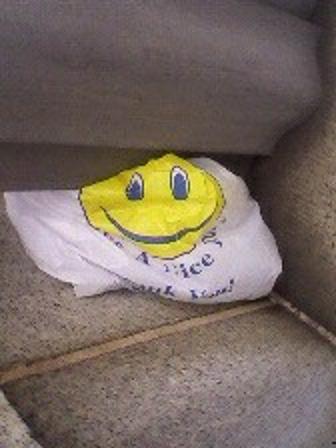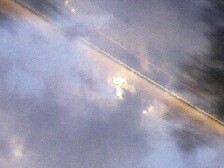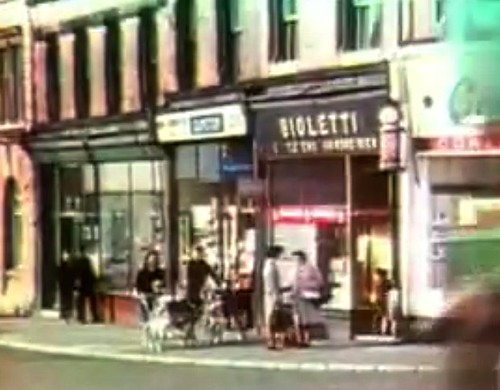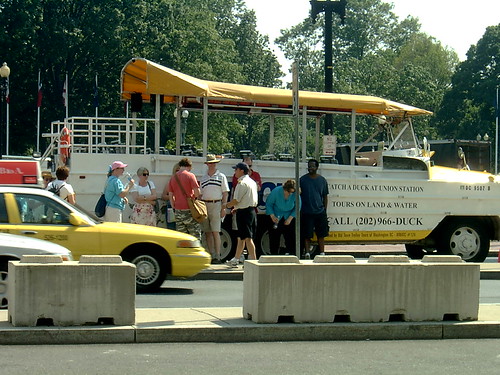Cherry blossom at Union Station

Rain coming
cherry petals
drift down
Christopher T. George
Aficianados of poetry will know that a traditional haiku has a set pattern of syllables, namely 5-7-5. I have been writing a number of haiku recently but also some shorter haiku, which I have named the hoku. It is also three lines, like the traditional haiku but less than the 5-7-5 syllables that a haiku calls for. No set number of syllables, just less syllables than the 17 syllables of a haiku. On a general basis, a hoku, despite the Oriental sounding name, is probably more fitted for Western verse than the usual nature theme of a haiku.
Herein are some examples of hoku and haiku.

Koi-ku Hoku
Gold
very fishy
fish
Emu-ku Hoku
Emu chick
to go to good home.
-- You?
Grackles in White Narcissi (Haiku)
Sleek black grackles
move through the white narcissi
as silent as sharks.
Hoku
I clear my
throat; you read
these lines.
Hoku Live
Here! Listen
to these
few words!
Astronomical Odds? (Haiku)
Path across night sky:
friendly visitor or foe?
You just do not know!
Christopher T. George

Funny Face
That smiley face bag stuffed in that space
has a certain imbecilic personality;
the snow's fast disappearing here in D.C.,
crocus in bloom in the Smithsonian gardens.
Dunned for a light by a bum with a dog end,
I see I've a hole in my crotch -- I mean,
my tan pants have a hole in the crotch area,
shame-faced when I'm supposed to be dressed up
for work, and the soles of my shoes need repair,
my wife and I need to go see the orthodontist;
our bought-used Saturn needs to be traded in,
our Twenties bathroom needs new grout.
I withdrew $50,000 from my retirement
to pay my mother's nursing home bills.
But -- just got word we'll get government help.
Gonna go around town wearing that smiley face.
Christopher T. George
Thursday, April 15, 2010
Haiku and Hoku
Posted by
Christopher T. George
at
10:38 AM
0
comments
![]()
Resurgence

What Mankind Hath Made
"Bay sees blue crab resurgence"
Baltimore Sun, April 15, 2010
As I smoke my cigar,
I watch a man with
bedroll on back pick
through an ashtray for
a gourmet smoke.
Tonight he'll sleep on
a grate in our capital;
I'll sip another Scotch,
toast my father who died
of cancer on this day,
a lifelong smoker.
Mankind giveth,
mankind taketh
-- despite the Dioxins
and Palmolive bottles,
the Blues survive!
And we remain the dirty
bomb in our own oyster.
Christopher T. George
Letter to Douglas Jemal, head of the Douglas Development Corp., owner of the Washington Coliseum, near the New York Avenue Metro station.
Hello Mr Jemal
I read in the Washington Post about the development about the "tombstones" appearing as an apparent anti-war protest on the roof of the old Washington Coliseum. [See link through title above]
As a rider on the Marc Train, as a Beatles fan, a man born in Liverpool, England, as well as a historian and a preservationist, I have been concerned for some time about what is going to happen with the Coliseum.
Have you thought of developing it as a Beatles Museum?
It would appear clear to me that the fact that the Beatles played there in 1964 is the building's greatest claim to fame, along with its long use for different events dating back to 1941 as a significant building in Washington, DC history that deserves to be preserved.
Washington, DC, is already a tourist destination and it would seem to me that as a museum on the famed Liverpool rock group that played there in 1964 this building could become a lucrative and interesting asset for the City of Washington and the Douglas Development Corporation much as the Beatles Story is in my native Liverpool. See http://www.beatlesstory.com/
Best regards
Christopher T. George
410-908-5634
http://christophertgeorge.blogspot.com/

Bioletti's Barber's Shop, Liverpool, from the Beatles' video of "Penny Lane." In reality, the barber's shop was at 11 Smithdown Place and not in Penny Lane, which is a road west of the old bus station.
You can download a copy of my article, The Bioletti Family of Liverpool: From the Maybrick Case to John Lennon and the Beatles, in pdf format. The article originally appeared in Ripperologist magazine at the time of the 2003 Jack the Ripper Convention held at Liverpool's Britannia Adelphi Hotel. Enjoy!
Posted by
Christopher T. George
at
7:12 AM
4
comments
![]()
Friday, April 09, 2010
Staying On Message

According to news reports, Republican National Committee (RNC) Chair Michael Steele's "longtime political consulting firm, On Message" has parted ways with him.
Are those the people who have kept Mr. Steele so "on message" that over the last year he has been a barely credible voice for the Republican Party? Are they the same people who advised him back in 2006 when he was running for the U.S. Senate in Maryland that it would be good to run an ad in which he said he liked puppies (click on the title above for my blog post from November 10, 2006 questioning Steele's credentials back then).
In a fit of self-denial, instead of recognizing his own shortcomings in being unable to run the RNC, Michael Steele is now saying that he is being picked on because he is an African American.
When he was interviewed by George Stephanopoulos on ABC's "Good Morning America" he was asked whether his race gave him a slimmer margin for error. In the sort of barely coherent and rambling statement that has become typical of his statements to the media, Steele answered:
"The honest answer is yes. It just is. Barack Obama has a slimmer margin. We all -- a lot of folks do. It's a different role for me to play and others to play, and that's just the reality of it."
It might be a different story if Mr. Steele had shown any competency as chairman of the RNC over the past year. It is truly significant that Republicans are showing no confidence in him and are refusing to funnel money to the RNC. Time for him to admit his shortcomings and to step down.

Tour Duck at Union Station, Washington, D.C.
Union Station Impressions
1.
This woman possesses
some powerful pheromone,
always has a man in tow;
pixie-like red hair,
leather knapsack on back.
Is she giving it away?
2.
A little chap, a miniature
man like British comedian
Ronnie Corbett, black hair
carefully combed, almost
shellacked, black-framed
glasses; he runs beside
the taller woman as if
craving her attention.
3.
Two elders: he walks
with aid of a twisted
briar, wears a safari
hat, grizzled gray
beard; she follows: jowly
with a sour look, gap-
toothed, wearing a yellow
t-shirt printed with coiled
snake, slogan exclaiming,
"Don't Tread on Me!"
Christopher T. George
Posted by
Christopher T. George
at
7:54 AM
2
comments
![]()
Friday, April 02, 2010
"Oh, say can you see. . . ?"
Hello All
I spent a pleasant day Thursday visiting Maryland Eastern Shore War of 1812 sites in brilliant spring sunshine and during which yours truly got some accolades as a published War of 1812 historian. I also was able to have some input talking to the group at various locations. The last stop was a beautiful colonial farmhouse on the Chesapeake Bay that was burned by the British in 1813. The owners had arranged tea, both hot and iced with mint, on the patio along with gourmet cookies, and there was a brilliant view looking out toward the Chesapeake Bay with black and white ospreys making their peeping cry flying overhead and other waterbirds, ducks and cormorants out in the water. (You can hear the cry of an osprey here.)
My friend Scott S. Sheads, long-time ranger-historian at Fort McHenry, was one of the speakers on the tour. He is an entertaining and informative fellow. Scott always delivers whatever he is saying in a deadpan manner, a very funny guy.
Scott said he had a lady come up to him at the Fort who told him that "The Star-Spangled Banner" is the Baltimore Orioles (baseball team) theme song and that she amazed to learn that it was actually the U.S. national anthem. Hard to know if it was a true story. Donna pointed out to me that on the "Oh!" of "Oh, say can you see. . .", the crowd always shouts out the word "Oh!" for "O" in "O-rioles" so there may be some truth in the story.
Scott is co-author, with Ralph Eshelman and Dr. Don Hickey of the new book, The War of 1812 in the Chesapeake: A Reference Guide to Historic Places in Maryland, Virginia, and the District of Columbia (Baltimore, Maryland: The Johns Hopkins University Press, 2010, which I highly recommend. Ralph was one of the tour leaders on yesterday's tour of Eastern Shore sites along with Mary Margaret Revell Goodwin who is working on saving part of the Slippery Hill Battlefield of August 1813 near Queenstown, Princess Anne County. See Eastern Shore 1812 Consortium.
For an article by me on Fort McHenry and the story of the Star-Spangled Banner titled "Birth of a National Icon" click on the title above.
I should add something more about Scott Sheads:
Scott is impassioned about honoring the men who fought in the War of 1812. In Spring 2006, when Robert Reyes and I were working on saving 9 1/2 acres at the center of the battlefield at North Point that had originally been slated for a supermarket that was never built -- land that is now, thankfully, safely in the hands of the State of Maryland's Department of Natural Resources as part of North Point State Park, Scott came along in a private capacity as a historian and citizen with Robert and myself to a meeting of the Board of Public Works in Annapolis. Some local Dundalk, Baltimore County politicians made a last-minute attempt to ask for an extension of Trappe Road across the piece of land, which effectively would have cut the land in half and defeated the object of trying to preserve as much of the battlefield as we could. (As many of you may know, a small section of the North Point Battlefield, known as "Battle Acre" was donated for public use to commemorate the battle by local landowner Jacob Houck in 1839; Battle Acre is on the west side of Old North Point Road south of Trappe Road, while the acres that needed to be saved, which formed the very centre of the Baltimore City Brigade under Brigadier General John Stricker on that memorable Monday, September 12, 1814, are on the east side of the road.)
Scott stood up before then-Governor Robert L. Ehrlich Jr. and Comptroller William Donald Schaefer (himself a former Governor of Maryland and Mayor of Baltimore) and spoke passionately about the sacrifice the militia of Baltimore had made on the battlefield and that therefore the land should be saved for posterity. Thankfully, both Governor Ehrlich and Mr. Schaefer agreed with Scott. Obviously, the land needed to be preserved to tell the story of the battle for future generations.
And long may it be!
Posted by
Christopher T. George
at
2:15 AM
0
comments
![]()